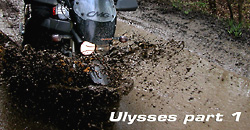
|
|
||||||||
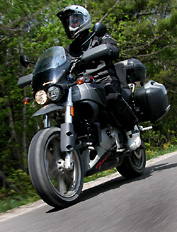 |
The Ulysses XB12X is something of a departure for the dogmatic, Harley Davidson-derived sportbike manufacturer, leaving the sportbike world and entering that of the dual-sport. Buell claim that the Ulysses is more than capable of handling the likes of gravel and fire roads, and yes, even jumps!
But at CMG we don't take what's fed to us without checking it out first and/or asking for extra pudding. With that in mind we suggested a long-term test might be in order. Buell said they could do it for eight weeks. We thought that was enough time to put it through the CMG wringer.
You can't say that they're not brave.
FROM THE GROUND UP
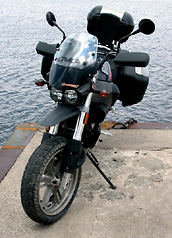 |
|
Full right lock – unimpressive. |
Founder Erik Buell, engineer and visionary, possesses some unwavering principles by which he designs his motorcycles – mass centralization and minimal un-sprung weight to name but two, applied with as much fundamentalist fanatical fervour to the Ulysses as any other in the previous Buell line-up.
The trademark (and rather excellent) aluminium beam frame and swingarm – now extended by 2” – hold all the whirly and noisy bits together, as well as provide a home for the fuel (frame) and oil (swingarm), keeping alive Erik’s weight reduction/mass centralization ethos.
Despite the moderated steering geometry and an extended wheelbase, steering remains fast and flickable – rapid direction changes are a piece of cake. Less pleasant was the tendency for the front-end to feel a touch remote – as if the front tire was constantly, if slightly, moving back and forth across the road. Interestingly the larger testers amongst us did not notice this behaviour, so perhaps those extra pounds up front make all the difference. That aside, if you had to swerve, hit a pothole or change your lines whilst cornering, the Ulysses would remain impervious. A big thumbs-up from me.
However, the worst feature of the Ulysses is undoubtedly the amount of steering lock available – several times I ever-so-nearly came to grief as the bars clanged against their stops, usually during U-turns. It looks like the frame and triple clamp limit the lock, which isn’t an easy one to solve and that on full left lock, the fork leg crushed a couple of cables – obviously undesirable.
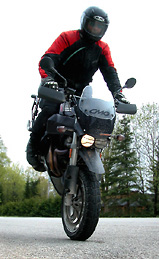 |
|
CMG brake testing. |
As with the other, sportier, XBs, the Ulysses retains the 375 mm perimeter mounted front brake and 6-piston caliper combo which is honkingly powerful. The front has a truly confidence-inspiring degree of feel – stoppies are easy and satisfying. The more conventionally mounted rear felt weak in comparison, but did the job without drama.
Beefed-up aluminium rims are fitted with 17” Dunlop D616 tires, which look more like racing wets, but provide plenty of grip on dry blacktop, though (ironically) slightly less when things got wet.
Showa suspension is fitted at both ends – a generous 6” plus travel provided by the inverted forks and adjustable rear shock. For a 165 lb rider, standard suspension settings provide a comfy, pillow-soft ride but manage to avoid the under-damped wibbly-wobbliness often associated with long-travel suspension.
DOES SHE GO?
The distinctly old-tech pushrod V-twin supplies 103 hp, but more importantly, a torque output of 84 lb-ft reveals more of its character: heavily undersquare, it’s a grunter not a screamer.
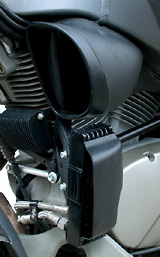 |
|
Ducts keep the rear cylinder and oil cool. |
Buell designates the motor as “air/oil/fan cooled”, with the front cylinder getting most of the air flow, meaning that the rear – nestled between the two frame beams – relies heavily on a fan to stay cool, with the air being drawn from a large duct at the front. It obviously needs all the cooling it can get, as the fan runs most of the time, even when you would least expect it – on a cool day, in the rain at a steady 80 km/h? Maybe it could do with a bigger oil cooler or another fan?
The oil cooler itself is mounted at 90 degrees to the air flow (to tuck it out of harms way) and is fitted with an air intake to direct the cooling air through the vanes.
Otherwise fairly normal, the motor is equipped with fuel injection and Buell’s version of an EXUP valve in the silencer, itself reinforced to act as a bash guard. Astoundingly, this old timer of a motor is not equipped with a catalytic converter, apparently passing the 2008 Californian emissions regulations, bereft of eco-trickery. Header pipes are finished with a coating that only became more attractive the more miles went by.
The uniplanar powertrain vibration isolation system (wot, no acronym?) allows the motor to be used as a stressed member, and is partially successful at keeping the vibes at bay – intrusive up to 2,500 rpm and when under load, reducing to a gentle buzz (although still enough to make the mirrors useless) thereafter. The strong idling vibes had Mr. Seck to standing up out of the saddle when stationary – so fierce were the vibes, he feared for the health of his (admittedly addled) brain ...
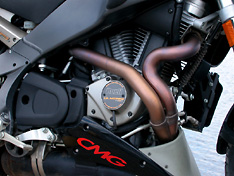 |
|
Pretty purple pipes. |
The motor feels reasonably strong, if a little short of revs, but that didn't stem the Ulysses' habit of lofting the front wheel into the stratosphere rather than digging-in and accelerating. With practice, the same effect could be felt over some fairly innocuous crests – gassing it on the approach would have the Ulysses eagerly catching air on the way over. Most entertaining
Primary transmission is via conventional chain. The rest of the gearbox however is new, with lower-inertia dog rings and helically-cut gears, supposedly giving easier shifting and allowing a long-life oil to be used. Whilst the clutch lever is reasonably light, the gear change was notably heavy, more so than previously tested Buell’s (and the first Ulysses test bike we had) which makes me think that we may had had an issue with our tester.
Final drive is via an aramid-reinforced toothed belt, which gains additional protection from stones, rocks and small mammals – it remained undamaged, un-maintained and unobtrusive throughout its tenure with me. Top marks.
BITS & BOBS
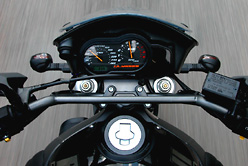 |
|
Clear clean clocks. |
Instruments consist of a twin dial pack, with a multifunction digital odometer/trip meter/clock combo (with handy-for-dunderheads reserve count-down), all very useful and indeed visible. Annoyingly, the ignition switch is neither, being mounted on the left side of the fairing, out of sight of the rider. A cowling and screen are fitted, and provide a modicum of wind blast protection up to around 120 km/h.
12V power outlets are fitted, one on the dashboard, one under the seat in the tailpiece – useful for GPS navigators and those who prefer their riding apparel electrically-warmed. Handlebars are hi-rise and fitted with plastic hand protectors – good for wind-blast protection but serious Baja-bashers are sure to opt for something more substantial. Mirrors were just plain rubbish due to the vibration, although sadly I can’t blame them for my speeding ticket ...
 |
|
Capacious colour-coded cases. |
Optional hard cases and top case were fitted to our test bike and proved to be well designed and capacious – they were simple to mount, lock and pack – but as with most cases, were not quite waterproof and actually shed a water seal from the joint just before the test was up. The rear case also has a 5 Kg weight limit, which you exceed at your peril. Careful loading is important on this machine if handling nastiness is to be avoided. Don’t ask me how I found this one out.
A two-piece grab rail is fitted for the pillion, which also provides the pivot for the “triple tail”, which swings in a 180 degree arc, making a luggage rack, passenger backrest and luggage pad respectively from back to front. It’s a neat idea, but I did find it prevents the topcase lid from opening fully when in the “backrest” position.
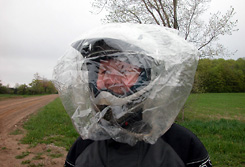 |
|
Jon shuts up. |
Solidly mounted and exquisitely-detailed aluminium footpegs provided a wide and grippy surface, without any intrusive vibrations and are mounted at a sensible distance from the saddle. Ah yes, that saddle – it shall forever be held up as a paragon of comfiness in a world of pain – universally praised and seemingly without fault in itself, it allowed the rider to shift positions and still remained comfortable and supportive over extended periods. Groovy.
Its height (841 mm) did cause some problems however, but seemed to suit the taller rider beautifully.
No centre stand is fitted (no chain to oil) but the side stand, although working fine, did have an odd way of working – it sort of flopped about until the weight of the bike was resting on it and didn’t inspire confidence at all – but as it worked, p’raps I should just shut up.
SHE'S A LOOKER
 |
|
This Buell means business. |
Buell have obviously taken care with this model, such is the quality feel it exudes. Coatings on the various parts are uniformly flawless, from the engine cases to the cast aluminium sub frame. The only failing part was the exhaust silencer, manufactured in some form of mild steel, the black coating was looking distinctly second hand – we were assured however that this would be a warranty item.
I personally found it an attractive bike, with a balanced, purposeful look to it. The wheels are a work of art and the engineering-detail-derived beauty of it really shone through to me – just look at the bends in those header pipes – exquisite. Others however thought it an aberration; “flat fecking ugly everywhere”, as one of our more acerbic testers noted. It does look slightly awkward from some angles but hey, I’m sure you’ll make up your own mind.
EVERYDAY LIVING
 |
The Buell is one of those bikes that makes me smile – once the motor is chuffing away (with a pleasing but restrained exhaust note), with its comfy riding position and flexible motor, you can just eat the miles up. Perfectly happy on the major highways, I think the Buell’s preferred environment is in the out-of-town, bumpy twisties, where its suspension remains unflustered and motor unstressed – just find the right gear and roll it on (and occasionally off).
With a view to long-term ownership, a maintenance-free belt drive, hydraulic tappets and cartridge oil filter all make for a feasible owner-maintained bike once the warranty period has expired.
Fuel consumption – and Buell recommends premium gas for the Ulysses – worked out at an average of 17.75 km/l. What was surprising was the variance in figures depending on the way it was being ridden, ranging from 24.75 km/l (gentle trundle 1-up), all the way down to 14.5 km/l (fully-laden highway blast) – giving an average range of 295 km. I was a tad confused (easily done) by the fuel capacity – Buell suggests it's 16.7 L, but somehow I managed to squeeze 18.55 litres in – either the tank is bigger or someone’s gas pump needs re-calibrating. Oh, and yes, I did pay for the right pump – I’m not that stupid.
 |
| Recalcitrant bag seal. |
I think it’s also important to look at what other comparably-performing litre-plus Adventure bike are available in Canada for your $14.5K. Head Europe-wards and the BMW R1200GS will cost you another $4K, the Ducati Multistrada 1000DS (more of which in an upcoming comparo article) is another $1.5K and if you’re brave enough to venture a little further eastward, you'll get a fat $2.5K in change if you opt for the bargain basement, but ever-popular V-Strom 1000.
DID WE BREAK IT?
One of our concerns when looking for a long-term test bike was that of reliability – previous Buell’s had, on occasion, shown themselves to be a touch fragile and we were keen to know if the Ulysses would follow suit. The bottom line is this; with the exception of a rusty exhaust and failed bag seal (both of which are warranty claims) the Buell remained fault free. Completely. Not a thing. Also bear in mind also that this is 8 weeks in CMG’s hands, pushing the bike further (literally, when I ran out of fuel) than most sane owners will.
DOWN AND DIRTY
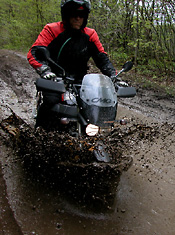 |
| The true test of a Dual Sport bike – trial by 'arris. |
That’s all nice and lovely isn’t it, but what about the dirty stuff? Buell have made this bike for limited dirt-bashing and so far all it’s seen in my hands is a determined 25 km blast along some of my local gravel roads.
Knowing that our readership would demand a no-holds barred test, our resident dirt maestro, Editor ‘arris took the Ulysses on one of the more gentle Rally Connex Dual Sport events, the Blue Mountain Adventure Ride, based out of Angus, ON.
In the upcoming part 2, 'arris explores the facts (and fiction) of the Ulysses' off-road credentials ...
THANKS TO:
The Rally Connex team for a splendid day out in the Blue Mountain Range, near Angus, ON. Top chaps.
Anna Dagher at the Comfort Inn, Barrie for providing us with suitably luxurious accommodation and a safe place to lock up our bikes.
SPECIFICATIONS
| Bike |
Buell Ulysses XB12X |
| MSL |
$14,369.00 |
| Displacement |
1203 cc |
| Engine type |
V-Twin, air/oil/fan cooled |
| Carburetion |
EFI |
| Avg. Fuel Cons |
17.75 Km/L (5.63 L/100 Km) |
| Avg. Range |
295 Km (Cap = 16.7 L (?) |
| Final drive |
5 speed, toothed belt drive |
| Tires, front |
120/70 ZR17 |
| Tires, rear |
180/55 ZR17 |
| Brakes, front |
Single 375 mm disc with 6-piston caliper |
| Brakes, rear |
Single 240 mm disc with 1-piston caliper |
| Seat height |
841 mm (33.1") |
| Wheelbase |
1381 mm (54.4") |
| Dry weight |
193 Kg (425 lbs) (claimed) |
| Colours |
Orange, Black |
| Warranty |
24 months (unlimited mileage) |
![]()